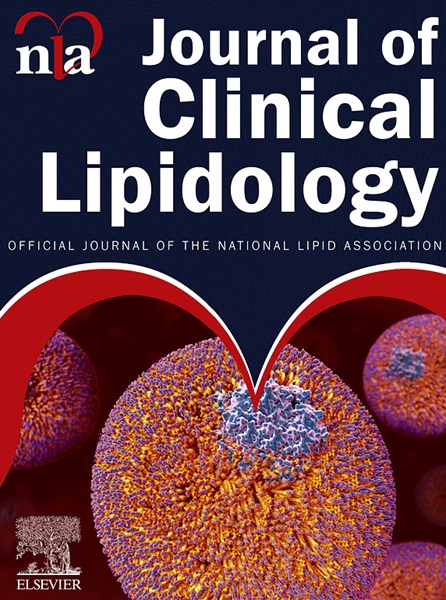血脂和降脂药与外周动脉疾病的关系:孟德尔随机研究
IF 3.6
3区 医学
Q2 PHARMACOLOGY & PHARMACY
引用次数: 0
摘要
血脂状况和降脂药物是否与 PAD 有因果关系,目前仍不清楚。解释血脂状况和降脂药物与 PAD 之间是否存在因果关系。在这项双样本孟德尔随机化(MR)分析中,我们利用与高密度脂蛋白(HDL)、低密度脂蛋白(LDL)、甘油三酯(TGs)、总胆固醇(TC)和 LDL 相关遗传变异()等血脂特征与外周动脉疾病(PAD)风险之间的因果关系进行了评估。该研究分析了来自全球血脂遗传学联合会和英国生物库的 1,654,960 人的数据,确保从遗传学角度全面深入地了解血脂功能障碍对 PAD 的影响。我们发现高密度脂蛋白(:0.83,95%:0.83-0.77)、低密度脂蛋白胆固醇(:1.29,95%:1.12-1.50)、总胆固醇(:1.14,95%:1.01-1.29)、总胆固醇(:1.16,95%:1.04-1.24)、(:1.31,95%:1.16-1.48)和(:0.84,95%:0.77-0.97)与 PAD 风险之间存在遗传预测关联。此外,的抑制与 PAD 风险降低相关(:0.68,95%:0.57-0.79,<0.001),而低密度脂蛋白抑制的其他三个基因代用指标包括(=1.21,95% : 0.87-1.69,=0.250)、NPC1L1(:0.77,95% 0.44-1.33,=0.344)和 APOB(:1.01,95% :0.87-1.26,=0.890)与 PAD 风险之间未发现相关性。根据遗传学证据,血脂异常是 PAD 的一个重要风险因素。PCSK9抑制剂可能是治疗PAD的有效策略。本文章由计算机程序翻译,如有差异,请以英文原文为准。
Association of lipids and lipid-lowering drugs with peripheral arterial disease: A Mendelian randomization study
It remains unclear whether lipid profiles and lipid-lowering medications are causally related to PAD. Explain whether there is a causal relationship between lipid status and lipid-lowering drugs and PAD. In this two-sample Mendelian randomization (MR) analysis, we assessed the causal relationship between lipid traits, including high-density lipoprotein (HDL), low-density lipoprotein (LDL), triglycerides (TGs), total cholesterol (TC), and LDL-associated genetic variants (), and the risk of peripheral arterial disease (PAD) using genetic variants associated with these lipid markers. The study analyzed data from 1,654,960 individuals derived from the Global Lipid Genetics Consortium and the UK Biobank, ensuring a robust and comprehensive genetic insight into the effects of lipid dysfunction on PAD. We found genetically predicted associations between HDL (: 0.83, 95% : 0.83-0.77), LDL-c (: 1.29, 95% : 1.12-1.50), TC (: 1.14, 95% : 1.01- 1.29), TG (:1.16, 95% : 1.04-1.24), (: 1.31, 95% : 1.16-1.48), and (:0.84, 95%: 0.77-0.97), and the risk of PAD. In addition, inhibition of was associated with a reduced risk of PAD (:0.68, 95% : 0.57-0.79, <0.001), while no association between the other three gene proxies of LDL inhibition including (=1.21, 95% : 0.87-1.69, =0.250), NPC1L1 (:0.77, 95% 0.44-1.33, =0.344), and APOB (:1.01, 95% :0.87-1.26, =0.890), and the risk of PAD were found. Based on genetic evidence, dyslipidemia is an important risk factor for PAD. PCSK9 inhibitors may be an effective strategy for the treatment of PAD.
求助全文
通过发布文献求助,成功后即可免费获取论文全文。
去求助
来源期刊
CiteScore
7.00
自引率
6.80%
发文量
209
审稿时长
49 days
期刊介绍:
Because the scope of clinical lipidology is broad, the topics addressed by the Journal are equally diverse. Typical articles explore lipidology as it is practiced in the treatment setting, recent developments in pharmacological research, reports of treatment and trials, case studies, the impact of lifestyle modification, and similar academic material of interest to the practitioner.
Sections of Journal of clinical lipidology will address pioneering studies and the clinicians who conduct them, case studies, ethical standards and conduct, professional guidance such as ATP and NCEP, editorial commentary, letters from readers, National Lipid Association (NLA) news and upcoming event information, as well as abstracts from the NLA annual scientific sessions and the scientific forums held by its chapters, when appropriate.

 求助内容:
求助内容: 应助结果提醒方式:
应助结果提醒方式:


